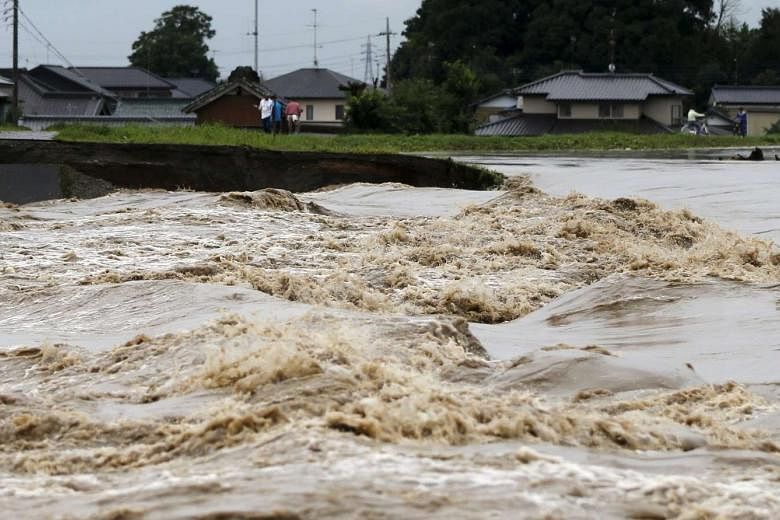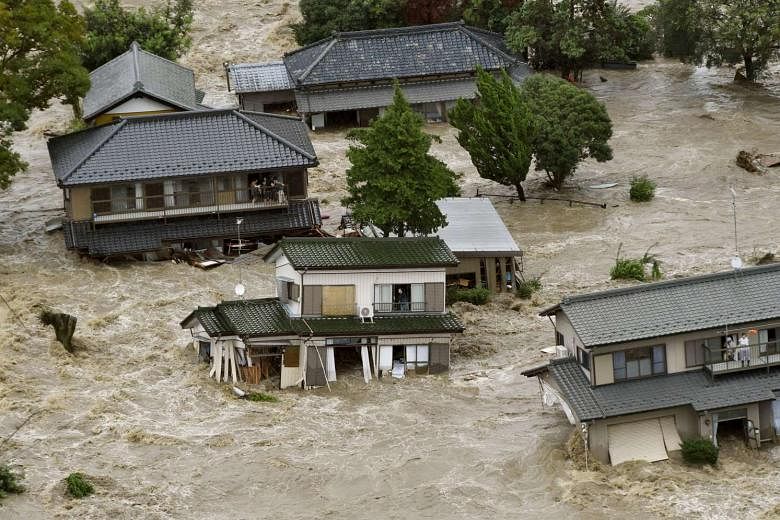JOSO CITY , Japan (AFP) - Nearly 700 people were awaiting rescue and at least 12 missing in Japan Thursday after torrential rains that saw a river burst its banks and deluge a city north of Tokyo.
Dramatic aerial footage showed whole houses being swept away by raging torrents in scenes eerily reminiscent of the devastating tsunami that crushed Japan's northeast coast in 2011.
Television images from Joso, a small city of 65,000, showed desperate residents waving towels as they stood on balconies trying to summon help after the levee on the Kinugawa river gave way, flooding an area that reports said spanned 32 sq km and included 6,500 homes.
Military helicopters plucked some stranded residents from roofs. One man was seen clutching a concrete post as waters swirled around him.
An estimated 690 people were still awaiting rescue as of 11pm (10pm Singapore time), the National Police Agency said, according to Kyodo and Jiji Press news agencies, 10 hours after the levee burst.
"Please continue to ask for help. Please don't give up hope," an anchorman for public broadcaster NHK told trapped viewers.
"I've never seen the Kinugawa river burst its banks," 63-year-old Joso resident Akira Yoshihara told AFP.
"My house is on higher ground but I'm worried the water may reach it tonight."
At least 12 people were missing after being swept away when the levee burst, the reports said, citing the prefectural government.
"We know the damage is extensive and affected wide areas," an Ibaraki official told AFP.
More than 100,000 people had been ordered to leave their homes after a huge swathe of northeast Japan was battered by torrential rain, with up to 60cm falling in some places.
The rains came in the wake of Typhoon Etau, which smashed through the country on Wednesday, bringing strong winds and causing travel chaos.
TRAPPED
Forecasters from the Japan Meteorological Agency had issued special warnings urging vigilance against mudslides and flooding in Joso and other parts of Ibaraki prefecture, with 20,000 people there told to seek shelter.
Joso is about 60km outside Tokyo, which has also been hit by localised flooding.
In neighbouring Tochigi prefecture, authorities ordered more than 90,000 people to evacuate, while another 116,000 were advised to leave their homes, broadcaster NHK said.
A 63-year-old woman died after a landslide in Tochigi, Kyodo reported.
Flooding complicated a contaminated water problem at the crippled Fukushima nuclear plant, where the site's drainage pumps were overwhelmed, sending radiation-tainted water into the ocean, a spokesman for operator Tokyo Electric Power said.
"This is a scale of downpour that we have not experienced before," forecaster Takuya Deshimaru told an emergency press conference.
Prime Minister Shinzo Abe said the government was on high alert, and vowed to put the "highest priority" on saving people's lives.
Two men were missing in Tochigi's Nikko, a city known for its historic shrines, after possibly being buried by landslides, NHK said.
Two other men in Nikko were rescued after being swept into a drainage gutter, but one was unconscious, the broadcaster said.
Etau, which smashed into Japan on Wednesday, moved out into the Sea of Japan (East Sea) by the end of the day, but a wall of rain continued to lash the country.
More than a dozen people were injured, including a 77-year-old woman who broke her leg after falling in strong winds, local reports said.
Japan is no stranger to natural disasters, and is frequently rocked by typhoons.
However, nothing in recent memory has compared with the tsunami of 2011, when more than 18,000 people were killed.



